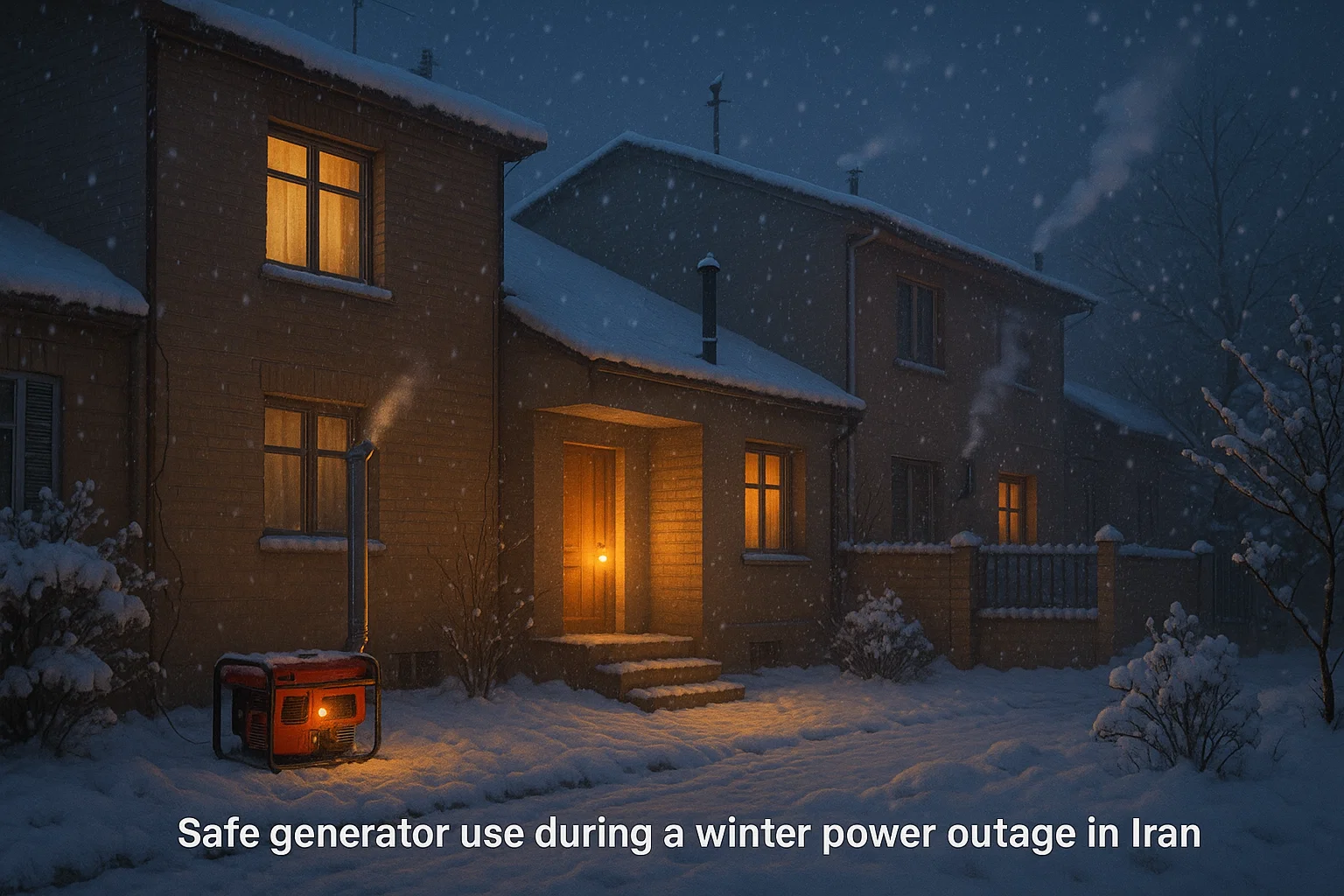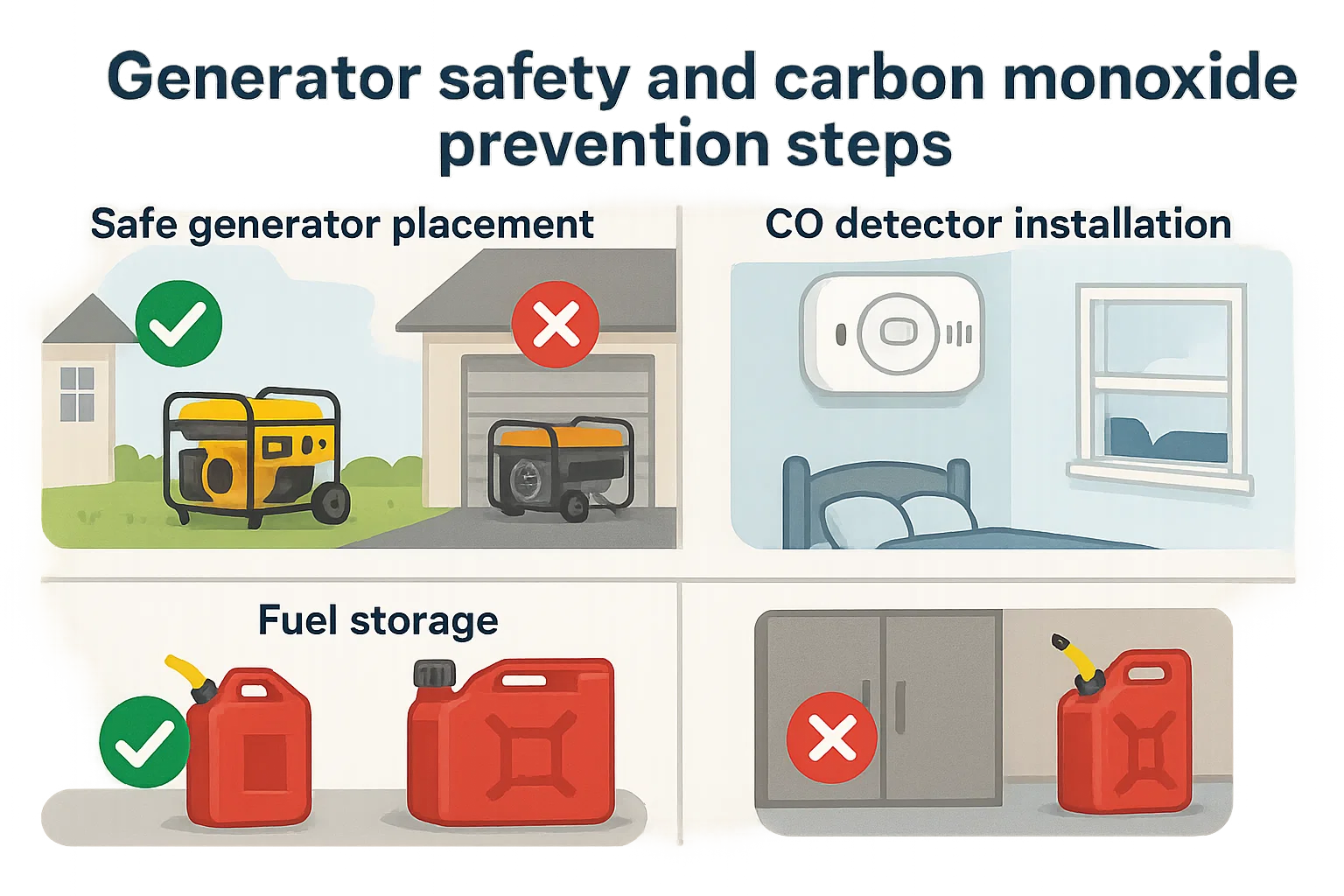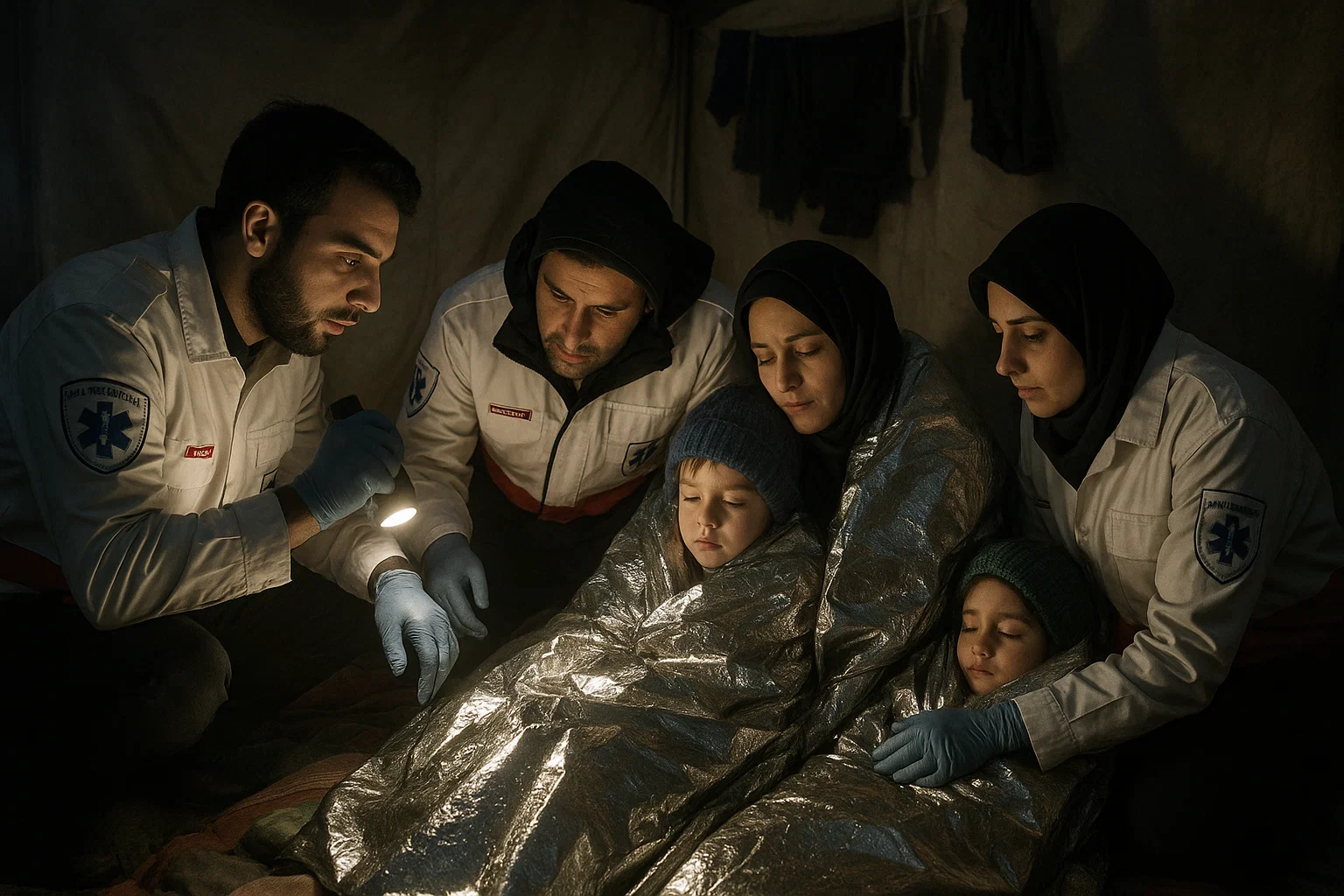
Understanding Winter Storm Power Outages in Iran
Iran’s diverse climate means that while the southern coast rarely sees snow, the central plateau and northern provinces like Tehran, Mazandaran, Kurdistan, and East Azerbaijan can face severe winter storms each year. These storms often bring heavy snowfall, freezing temperatures, and prolonged power outages that disrupt heating, lighting, and emergency communications.
When the grid goes dark, families turn to generators, gas heaters, or makeshift fires, sometimes indoors and that’s where most emergencies begin.
According to Iran’s National Disaster Management Organization (NDMO), most winter storm casualties are caused not by the storm itself but by unsafe heating methods, carbon monoxide poisoning, and untreated hypothermia.
This guide, written by Alex Smith, an EMT-Paramedic with over 15 years of field experience, walks you through what to do before, during, and after a winter power outage.
You’ll learn how to operate generators safely, prevent CO buildup, and recognize early signs of hypothermia with practical steps applicable to both rescuers and households.
Operational Context: Why Power Outages Turn Deadly
During a storm, high winds and ice accumulation damage overhead power lines. Rural areas in Iran often depend on older distribution systems, meaning it can take hours or days for electricity to be restored. Meanwhile, people resort to improvised heating or lighting options that introduce three critical hazards:
- Carbon monoxide (CO) poisoning from indoor generator or heater use.
- Fire outbreaks caused by fuel leaks or poor ventilation.
- Hypothermia and frostbite due to prolonged exposure to cold.
These emergencies compound when roads are blocked, ambulances can’t reach homes, and cellular networks fail isolating entire communities.
Emergency Procedures and Response Steps
1. Before the Storm
Preparation saves lives. Before a storm hits, every household should run through this checklist:
Winter Power Outage Preparation Checklist
| Item | Action | Notes |
|---|---|---|
| Generator | Test monthly and ensure 5–10 liters of fresh fuel stored safely | Keep outdoors during operation |
| Carbon Monoxide Alarm | Install at sleeping height in each room | Test batteries monthly |
| Heating | Use kerosene/gas heaters with ventilation | Never close all windows |
| Medical Kit | Include thermometer, blankets, glucose, hand warmers | Recheck expiry every winter |
| Communication | Keep power banks charged; have radio batteries | Prefer crank radios for long outages |
| Fuel | Store in approved containers, 5 meters away from living space | Never refuel while running |
Pro Tip #1: Run a “blackout drill” at least once before winter to ensure all family members know what to do if the power fails.

2. During the Outage
When the lights go out, calm coordination matters more than speed. Follow this step-by-step protocol for households and responders:
Step 1: Secure the environment
- Turn off all major electrical appliances to prevent surge damage.
- Ensure candles and heaters are stable and never left unattended.
- Check generator exhaust points are unobstructed by snow.
Step 2: Start the generator safely
- Operate at least 6 meters away from doors, windows, and vents.
- Never place it in garages, basements, or under balconies.
- Use ground-fault protection (GFCI outlets or surge strips).
- Refuel only when the engine is off and cool to touch.
Step 3: Manage temperature
- Insulate a single “warm room” by closing off unused areas.
- Cover windows with plastic sheets or blankets to trap heat.
- Use body heat and layers rather than open flames.
Step 4: Watch for symptoms of CO poisoning
Common early signs include:
- Headache, dizziness, nausea, or confusion.
- Weak pulse or cherry-red lips (advanced stage).
If multiple people show these signs, evacuate immediately and call EMS.
Pro Tip #2: If your generator or heater flame turns yellow instead of blue, ventilation is inadequate open windows immediately.
Step 5: Monitor vulnerable individuals
Infants, elderly, and chronically ill people lose body heat faster.
Check body temperature every 2–3 hours; if it drops below 35°C, begin rewarming measures.
3. After Power Restoration
When electricity returns:
- Turn off generators first before reconnecting appliances.
- Dispose of old fuel properly never pour it down drains.
- Ventilate the house for 30 minutes to remove residual fumes.
- Reset CO detectors and inspect the generator for wear or leaks.
Pro Tip #3: Add post-storm debriefs in community safety training to learn from each incident.

Hypothermia and Cold-Weather Medical Response
Hypothermia is one of the silent killers of winter blackouts.
Even indoors, temperatures below 10°C can lower core body temperature dangerously fast.
Signs and Symptoms
| Severity | Core Temp (°C) | Symptoms | Recommended Action |
|---|---|---|---|
| Mild | 35–32 | Shivering, confusion, fatigue | Move to warm area, change wet clothes |
| Moderate | 32–28 | Slurred speech, drowsiness, slow pulse | Apply warm compresses to armpits/groin, wrap in blankets |
| Severe | <28 | Unconsciousness, shallow breathing, weak pulse | Call EMS, avoid rough handling, continue gentle warming |
Pro Tip #4: Never give alcohol or caffeine to someone suspected of hypothermia. Both worsen heat loss.
Rewarming Techniques (Household Level)
- Remove wet clothing and replace with dry, insulated layers.
- Use warm not hot water bottles wrapped in cloth on chest and neck.
- Share body heat through skin contact under a blanket if trained and safe.
- Monitor pulse and breathing every minute until EMS arrives.
Equipment & Tools
Generator Safety and Selection
| Equipment | Specification | Recommendation |
|---|---|---|
| Portable Generator | 3–5 kW capacity | Suitable for small homes; check NFPA 70 guidelines |
| Extension Cords | Rated for outdoor/heavy-duty use | Avoid coiling; inspect insulation regularly |
| CO Detector | 10-year sealed battery model | Install near sleeping areas |
| Fuel Canisters | UL-listed, color-coded (red for gasoline) | Keep outside, shaded area |
| Insulation Materials | Thermal blankets, foam seal strips | Use in doors/windows during outage |
Inspection & Maintenance Cycles
| Frequency | Task |
|---|---|
| Weekly | Test CO alarm and inspect generator cables |
| Monthly | Run generator 15 minutes under load |
| Quarterly | Replace old fuel and clean air filter |
| Annually | Professional servicing (spark plug, oil change, valve check) |
Field Scenarios and Case Applications
Scenario 1: CO Poisoning in a Tehran Apartment (2024)
During a February snowstorm, a family operated a gasoline generator inside their kitchen. Within two hours, all four members showed confusion and headache. The father collapsed before EMS arrival. Responders recorded 35% COHb levels near-fatal. Proper outdoor placement could have prevented the tragedy.
Lesson: Never use generators indoors, even with open windows. CO is odorless and heavier than air it lingers.
Scenario 2: Rural Mazandaran Hypothermic Elderly Rescue
An elderly woman living alone used a kerosene lamp during a 24-hour blackout. Temperatures dropped to -5°C, and she was found unresponsive. EMTs initiated passive rewarming and warmed IV fluids during transport. The patient survived, but frostbite affected her toes.
Lesson: Regular welfare checks and neighborhood communication networks save lives.
Scenario 3: Generator Fire in Kermanshah
A 5-kW generator stored on a balcony leaked fuel, igniting during refueling. The homeowner suffered minor burns; fire crews contained the blaze within minutes.
Lesson: Always shut off and cool generators before adding fuel. Keep extinguishers rated Class B nearby.
Training and Safety Guidelines
Community Drills and Education
- Conduct winter safety sessions every November under Red Crescent Society supervision.
- Include generator demos, CO alarm installation, and basic first aid for hypothermia.
- Distribute laminated checklists to households and schools.
Communication During Outages
Iranian EMS teams operate under ICS (Incident Command System) adapted from global frameworks. For community responders:
Basic ICS Protocol During Power Outages:
- Incident Commander: Usually the senior municipal officer.
- Operations Section: Fire, EMS, and road-clearance units.
- Logistics Section: Manages shelters, power distribution, food, and fuel.
- Public Information Officer: Issues verified updates to citizens.
Clear, consistent messaging reduces panic and misinformation especially when mobile networks are disrupted.
Pro Tip #5: Every local rescue team should pre-assign one radio channel exclusively for storm response.
Pro Insights What Professionals Actually Do
- Separate power circuits: Emergency shelters have isolated wiring to prevent back-feed.
- Portable oxygen and heaters: Ambulances carry both during winter for hypothermia and CO cases.
- CO detectors in all EMS units: Mandatory per Iranian EMS safety protocol.
- Community liaison officers: Check on isolated homes after 12+ hours of blackout.
- Fuel control sheets: Every generator log includes start/stop times, fuel use, and last inspection.
- Thermal imaging cameras: Used to locate trapped or unconscious victims in unheated rooms.
- Buddy system: Rescuers work in pairs to monitor each other’s exposure and fatigue.
- Public messaging: Repeat safety messages hourly through local radio and mosque loudspeakers.
FAQs
Q1: What is the safest distance to place a generator from the house?
At least 6 meters (20 feet) away from doors, windows, or air vents, preferably on level ground with no snow accumulation.
Q2: Can I run a generator in my garage if I keep the door open?
No. Even partially open garages trap CO. Always operate generators outdoors.
Q3: How long can a person survive without heat in freezing temperatures?
Depending on clothing and insulation, hypothermia can develop within 30–60 minutes at 0°C indoors, faster if wet.
Q4: What kind of extinguisher should be near a generator?
Use a Class B or ABC fire extinguisher, rated for fuel and electrical fires.
Q5: What’s the first thing rescuers check in CO incidents?
Airway and consciousness level. Pulse oximeters may misread; COHb monitoring or immediate oxygen therapy is preferred.

Alex Smith, a seasoned medical technician with 15 years in ambulance services, writes crucial first-aid tips and emergency care insights on arescuer.com.
